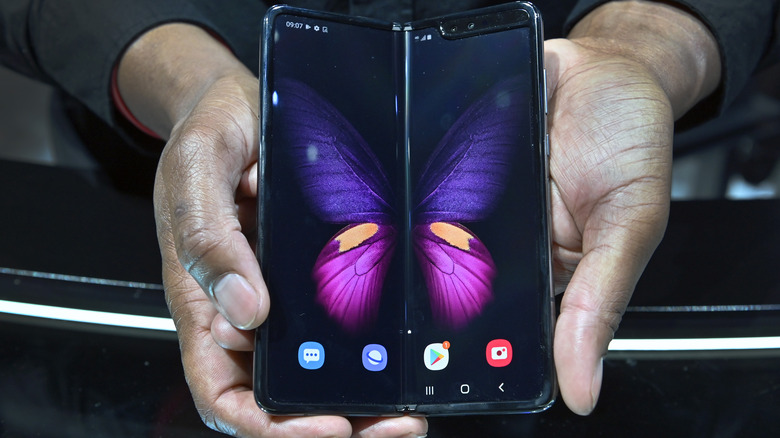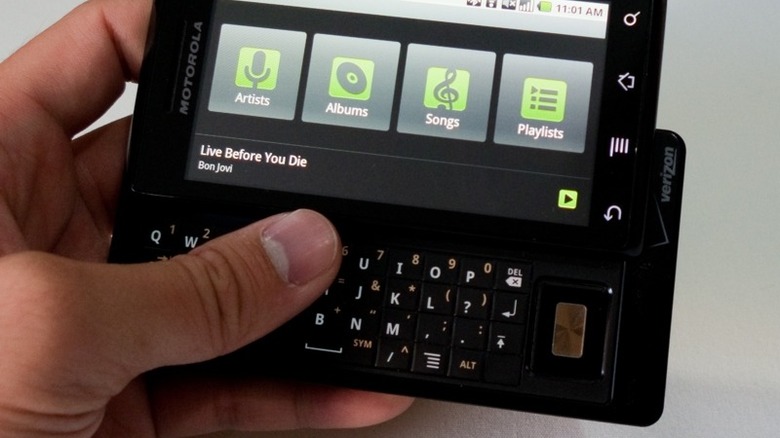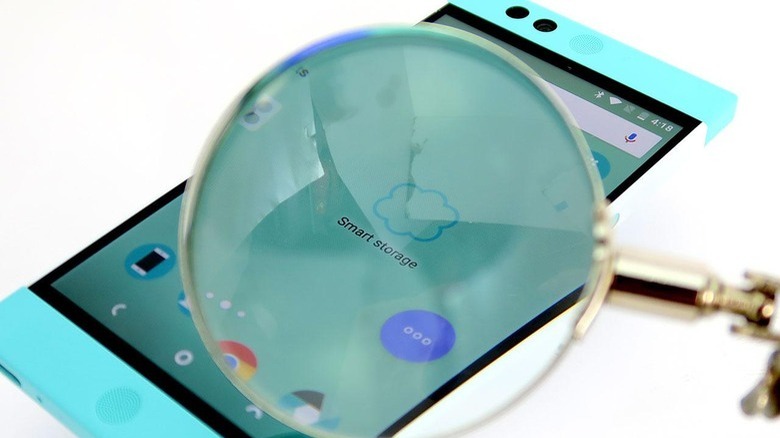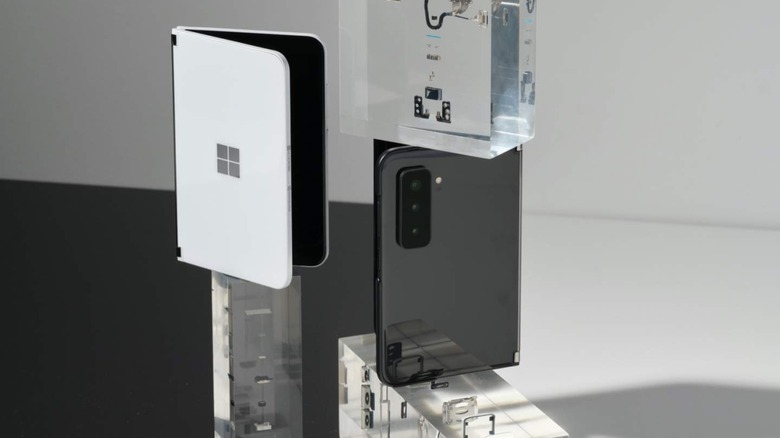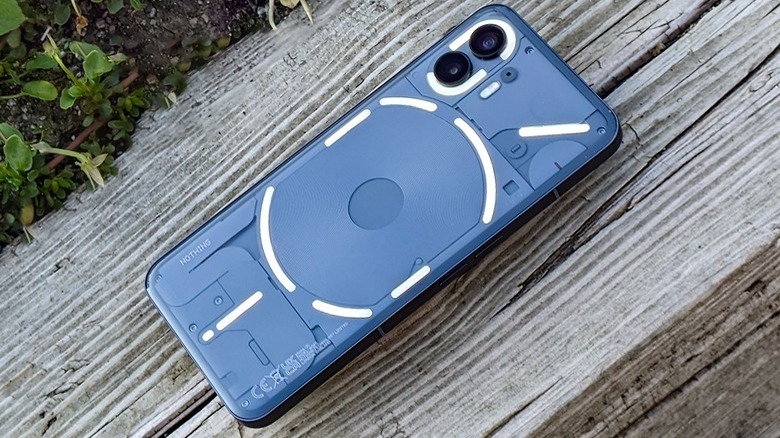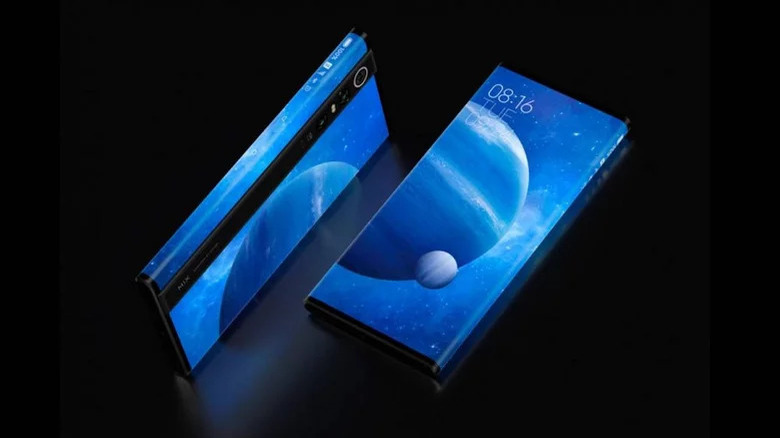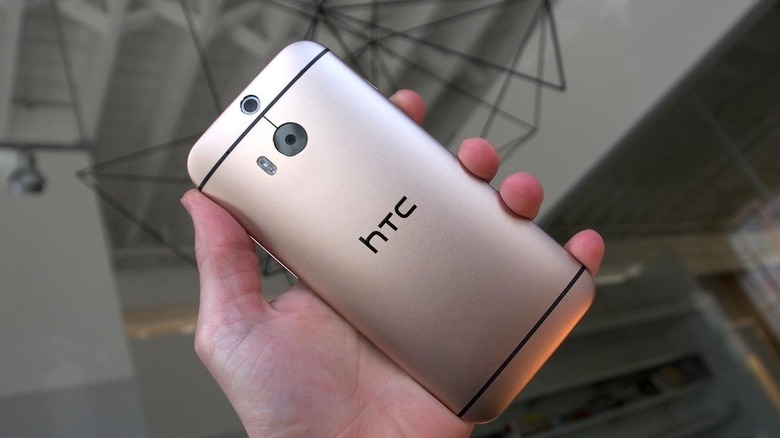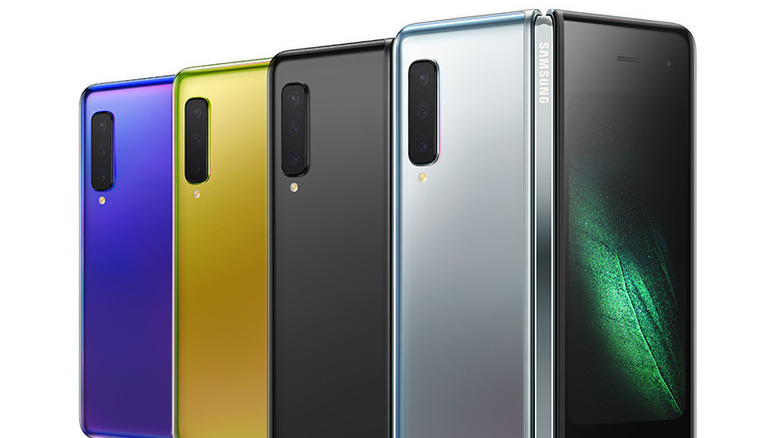7 Of The Coolest Looking Android Phones Ever Made
Over the long history of Android, Google's OS has become the most popular on the planet, even beating out Windows. That's because it's been powering thousands of devices in various shapes and sizes, all made from different manufacturers over the years. From simple candy bar-style slab phones to folding screens, and extending into the realm of truly bizarre devices, Android can be made to work with nearly any form factor. But while the majority of Android devices range from boring to weird, every so often a truly impressive device is released that blows people's socks off from the very first look.
Since Apple only releases a few iPhones each year, it doesn't have much room to deviate from the norm. But in the world of Android, there are a number of companies ranging from massive sales to niche enthusiast devices, meaning there's a lot more incentive for companies to make devices that stand out from the crowd. However, while making a phone weird is one thing, making it look cool at the same time is much harder. You're more likely to make an ugly duckling like the LG Wing than you are a technological work of art like the Nothing Phone.
Here is a list of the coolest looking Android phones ever made. Some come from the early days of the platform, while others are still shiny and new. But what they all have in common is a design that stands the test of time.
Motorola Droid
The Motorola DROID was not the first Android phone to hit the market, but for many people, it was their first introduction to the iPhone alternative. Thanks to an exclusive deal with Verizon, the Droid launched with an advertising blitz that made the phone seem inescapable. With the iPhone still an AT&T exclusive in those days, Verizon wanted the Droid to stand toe to toe. Verizon even paid to license the term "droid" from Lucasfilm and its Star Wars universe.
The Droid's design looks quaint more than 14 years after its late 2009 launch. There's the plastic front with the four hardware keys that helped people navigate the early versions of Android. The device also had an 854x480 TFT LCD display measuring 3.7 inches, just a bit more than the iPhone's 3.5 inches. Its real trick was under the screen though: If you turned it to landscape and slid the screen up, a physical keyboard would appear, complete with a D-pad.
At the time, the thing looked downright alien, and that was the impression Moto and Verizon hoped to convey. Its hard angles contrasted boldly against the demure softness of the iPhone's curves. Verizon and Motorola also included an alien startup noise that made it seem like the Droid had arrived from another planet.
Nextbit Robin
The Robin, a short-lived phone from short-lived company Nextbit, had a solid idea. Its premise was that in an increasingly cloud-based computing paradigm, who needs local phone storage anymore? Well, as it turns out, more people than you'd think, which is part of why Nextbit and the Robin failed. But whatever the flaws in its conceit, the Robin was a gorgeous bit of eye candy. It quickly funded its Kickstarter campaign and became a real product, releasing in February 2016.
It's hard to overstate the design work that went into the Robin. In his review for SlashGear, Chris Burns noted the Nextbit Robin hardware was partially designed by one of the same people who worked on the original HTC One, another phone on this list. Even though that phone was metal and this one is plastic, the Robin still looks every bit as premium. It's a big box of a phone, which made it look imposing when gaming hardware company Razer reused the design for the Razer Phone, but the soft blue colors make the Robin look inviting. True to its name, the plastic chassis was a robin egg blue which contrasted with a sky blue at the top and bottom.
Unfortunately, the Robin only came with 32 GB of internal storage. The idea was to promote the included free 100 GB of cloud storage, but even in its launch year of 2016, that wasn't enough for most people. A second phone never arrived.
Surface Duo 2
While it came with frustratingly bad software, Microsoft's second attempt at a dual-screen foldable phone had gorgeous hardware. After finally putting Windows Phone to pasture in 2017, Microsoft embraced its erstwhile rival in Google and got to work manufacturing Android phones while deepening the link between Android and Windows. One of the best examples was 2020's Surface Duo, a "folding" phone with two noncontiguous displays. Reviewers praised its design, but didn't like its software or $1,400 asking price, Microsoft tried again, with the Surface Duo 2 in 2021. The device was an absolutely gorgeous piece of hardware, but it was still bogged down by a lackluster software experience. Likely, sales weren't very high, since Microsoft hasn't released a third Duo.
The Surface Duo 2 was pitted against the Samsung Galaxy Z Fold 3 at the time of its release, proving just how far ahead other foldable phones were in terms of actually having screens that folded.
In theory, there were some ways it was better than other foldables. The Duo's two separate screens allowed the device to fold backward, giving the user a single screen, while apps like e-readers made the Duo 2 feel more like a real book. And, when closed, the innermost parts of those screens were visible to display the time and notifications. Oh, and the Duo 2 supported a stylus just like its bigger siblings in the Surface tablet lineup.
Nothing Phone 1 and 2
While a number of the brands in this list are somewhat defunct when it comes to smartphones, Nothing is a newer brand that's still going strong. Launched by Carl Pei, the former director of OnePlus, Nothing has so far produced two phones worthy of this list. The attention-grabbing design of Nothing's phones, named Phone 1 and Phone 2, have helped them stand out from a sea of boring glass slabs in the current smartphone market. The retro-futuristic designs make even more sense once you know that Nothing teamed up with Teenage Engineering, the too-cool-for-school design firm that recently collaborated to design the Rabbit R1 AI gadget.
A fair criticism of Nothing phones might be that they look a lot like iPhones if you squint at them, but these bespoke designs have a lot going on in the trunk. The best example is the Glyph system, a series of lights on the backside of the Nothing Phone that alert the user to different notifications, charging status, and even how close an Uber is. The lights are scattered among a transparent design that lets the user see through to the phone's internals, while the flat metal rails along the sides give the device a somewhat boxy look. From the front, however, the Nothing Phone 1 and Phone 2 both look pretty standard. Only once you turn them on do you see the matrix-dot-inspired black-and-white skin Nothing has built for its version of Android.
Xiaomi Mi Mix Alpha
While it never came to market, the Xiaomi Mi Mix Alpha was a phone that got rid of all its bezels and then some. The device featured a nearly 360-degree wraparound display, making it probably the most scratch-prone device ever. But it was undeniably cool.
The Mi Mix Alpha looked like any other high-end smartphone from the front. But turn it to the side and the curved screen kept on curving. There were no side rails, nor was there a backplate. It's all screen! Well, almost. A digital screen has to have sides, not matter how hidden, so a narrow strip of glass ran across the back left of the device, which also housed its triple-camera array.
The wraparound display wasn't merely a gimmick. One side could display the time and notifications, while the other had virtual buttons for power and volume. Imagine programmable buttons appearing when needed, like a camera shutter or voice recorder. The back of the phone, meanwhile, had an array of widgets, including a music player and timer.
As you might imagine, one of the challenges here was touch rejection while using the phone like a normal smartphone, but that wasn't what ultimately sunk this ridiculously cool looking smartphone. Unfortunately, Xiaomi couldn't figure out a reliable way to produce the Mi Mix Alpha at scale, so the alpha and its wraparound screen were axed. As a result, very few people ever got their hands on one.
HTC One M8
There was a time when HTC's dominance of the Android market was next to unquestionable. The company was consistently producing unique smartphones that blended interesting ideas with eye-catching designs. HTC's crown jewel came in 2014, with the HTC One M8. Even now, an entire decade later, the One M8 still looks every bit as sleek, futuristic, and premium as the day it hit store shelves.
The One M8 may look a little dated with a pair of Boom Sound speakers flanking its screen from the top and bottom, but they were a selling point at a time when most phones had lackluster sound. The rest of the One M8 was where it really shined. The device's back and sides were a unibody aluminum frame that curved in your hand.
And it isn't just gorgeous on the outside. In an era where Android software was often ugly, HTC's Sense software was tasteful, packed with thoughtful features like customizable themes, a news feed, and a gallery. For the Google superfans, there was a version running stock Android.
Unfortunately, while the One M8 represented a pinnacle of HTC's smartphone design, it turned out to be more of a cliff than a peak. HTC did release a followup to the One M8 the next year, but then the company's smartphone fortunes took a massive tumble. Eventually, HTC faded into a distant memory, but its classic designs do live on since Google acquired HTC's design team to make Pixel phones.
Samsung Galaxy Fold
Has there ever been an idea so cool that no amount of bad press could sink it? When Samsung launched the original Galaxy Fold in 2019, it learned the answer was a resounding yes. Despite a wide range of durability issues that made the original Galaxy Fold a dumpster fire of a release, Samsung's first folding phone rebounded because it was such a promising idea.
The Galaxy Fold had been rumored for a while, but it still seemed hard to believe when it was unveiled. The public had never seen a mass production smartphone with a screen that could fold in half. Although it had a chunky form factor and thick bezels, that magical display was enough to cement the Fold as an iconic device from the get-go.
Quickly, issues became apparent. The foldable display was so fragile that many seasoned tech reviewers accidentally destroyed their Galaxy Fold units while trying to remove the included screen protector. Even those who left their protectors intact reported that the thin plastic started peeling up from the display. Things got even worse once people realized that debris could enter the hinge and break the Galaxy Fold from the inside. Samsung ultimately delayed the release of the Galaxy Fold to add durability.
The core idea of the Galaxy Fold was so strong that those who wanted a foldable future were not deterred. A slightly rebranded Galaxy Z Fold 2 fixed many of the issues, and Samsung has continued iterating from there.
